|
H260 Trailer Mods, Maintenance and
Setup
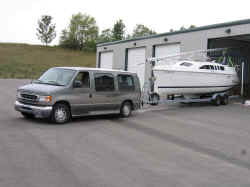
Click to expand
The H260 Trailer is a fairly frequent
discussion item on the hunterowners.com forum. If you are
modifying a trailer to fit the H260, check these dimensions for the stock
trailer manufactured by Magic Tilt. The Majic Tilt trailer has
surge brakes on one axle. Virtually all boat trailers have surge
brakes while electric brakes are common on travel trailers.
However, since electricity, salt, and water really don't mix
well, electric boat trailer brakes are rare because they require
more maintenance.
A properly loaded trailer has about 9 - 12 percent of its
weight on the tongue. The stock trailer weighs 1280lbs. The
combined H260 trailer & boat combination weighs almost
5800 pounds with a tongue weight of 600 pounds including water,
engine. Adding the usual "stuff" probably adds another
250 pounds or so. Make sure you have a vehicle that is capable
of handling this load safely. There
is a lot more on this subject at this link.
Maintenance instructions for the
trailer are at this link: H260
Trailer Maintenance
Loading the trailer
The Magic Tilt
trailer for the H260 is versatile and durable. However, it is
sometimes hard to get the boat centered on the trailer.
Many owners have added a keel alignment device so that the boat
automatically centers itself. Here's my approach.
|
click
any picture to expand |
|
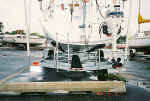
|
|
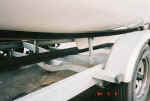
|
|
Before: Misaligned
keel on bottom bunk |
|

|
|
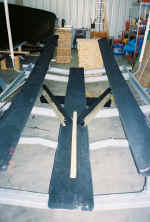
|
|
Alignment device
construction pictures |
|
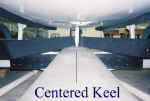
|
|
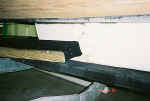
|
|
After: Properly
aligned keel |
Binding on Trailer hitch extension
It can also be a
challenge to pull the tongue extension out. There is an upward pressure on
the ball end of the bar forcing the other end of the bar down
causing some binding. The lip welded on the cross piece at the
aft end of the tongue helps distribute the weight from the
forward to the back of the tongue.

Early
on, I tried to extend the tongue by hand but it was too
stiff. I greased the tongue but all that did was attract sand
and dirt making it even harder to slide in and out and I ended
up with black grease stains all over everything. What a mess!
Hunter recommends using the vehicle to extend the tongue. Some
people also advise slacking the winch cable before pulling the
extension out.
I have not
found a gentle way to do this. I block the trailer wheels and
use my car to extend and contract the tongue. This works OK for
pulling the bar out, but by using the car to slide it back in
place I have distorted the crossbar a couple of inches in the
middle where the tongue slams into the crossbar. Most of the
summer the boat is on a mooring, but when I dry slip the boat I
leave the tongue extended in between sails and I now try to keep
the tongue from slamming into the crossbar.
Inserting
the pin
Getting the extension pin in and out can also be a struggle. I
use a large heavy duty screwdriver to align the top and bottom
holes. One owner reports good results using a large marlin spike
to align the hole. Another has ground the stock pin to a
point. A hammer is sometimes needed to align the holes and drive
the pin home.
This year,
I'm going to take the whole thing out of the tube, clean it
good, straighten the cross bar, and try to come up with a better
technique for pulling the tongue in and out.
Click any Picture to Expand
 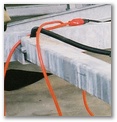  
Other Stuff:
The front roller can easily scratch the hull during loading.
Here's an idea for fixing this problem. Some owners have
replaced the black roller with the non-marking kind. Also, don't
forget to carry a spare tire and hub. Check the winch cable for
breaks. Also, check all bunk brackets on the trailer.
Click any picture to expand
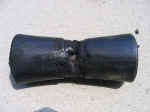 |
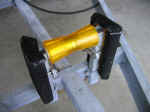 |
Left: Stock bow roller
lasted two seasons & left black marks on bow
Right: This is the replacement roller.
Note the roller guard to prevent scratches to the bow when
loading the boat. |
|
 |
Another owner alerted me to the possible problem
of broken trailer bunk brackets. When I checked, one was
broken completely. Bought several brackets from http://trailerpartsdepot.com
The item code is PT2060,Bunk,Bracket Angle (Mt Ld) $1.04
each. I bought 5 because that was the minimum order
quantity. |
|
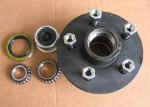 |
Check the boat yard. How trailers
do not have a spare tire and hub?
The brakes/bearings on my trailer are
made by
Unique Functional Products (UFP). Go to the UFP website for
information on maintenance of trailer brakes and bearings
To extend the life of your tires here
are some suggestions:
For short term storage: Store in cool, dark place at
maximum inflation. Use tire covers to protect the tires
from direct sunlight.
For long term storage: Put the trailer on blocks to take
the weight off the tires, lower the air pressure and cover
tires to protect from direct sunlight. Care should be
taken to avoid prolonged tire contact with petroleum based
substances: oils, fuels and asphalt. Use thin plywood
sections between the tire and the pavement. Note: put
jacks and blocks under the axles not the frame.
Age: Trailer tires don't get enough miles on them to show
significant wear. Replace trailer tires every five to
seven years, whether they look like they're worn or not.
Other: After a blowout on a tandem-axle trailer, you
should consider replacing both tires on that side. The
remaining tire was likely subjected to excessive loading
and, as a consequence, may fail in the near future.
|
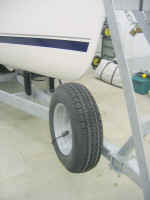 |
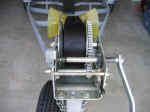 |
Nylon winch cable is easier on the hands
than wire.
|
Click HERE for More Pics and
Discussion on the H260 Trailer
|